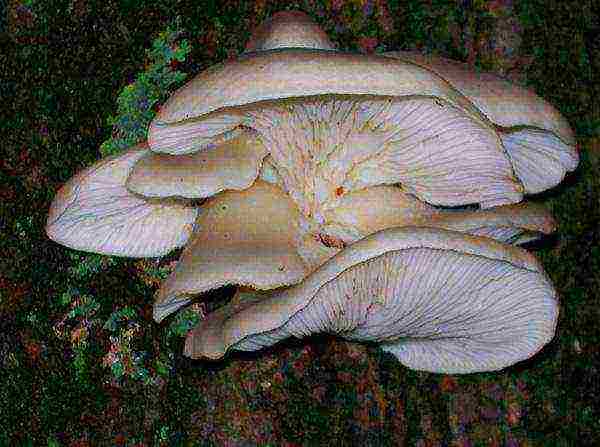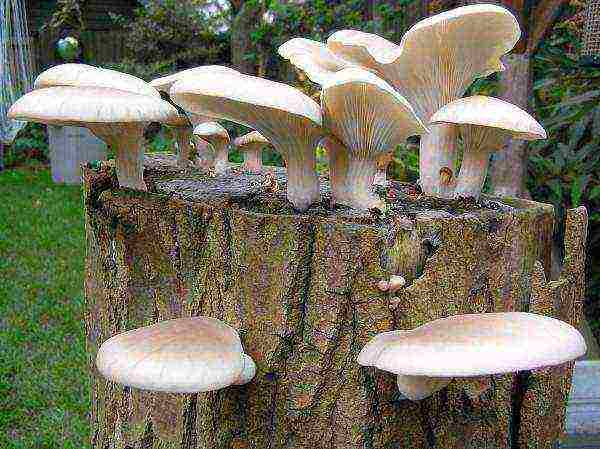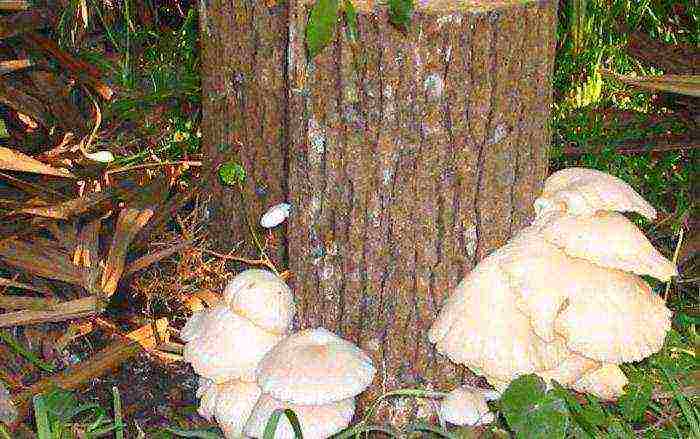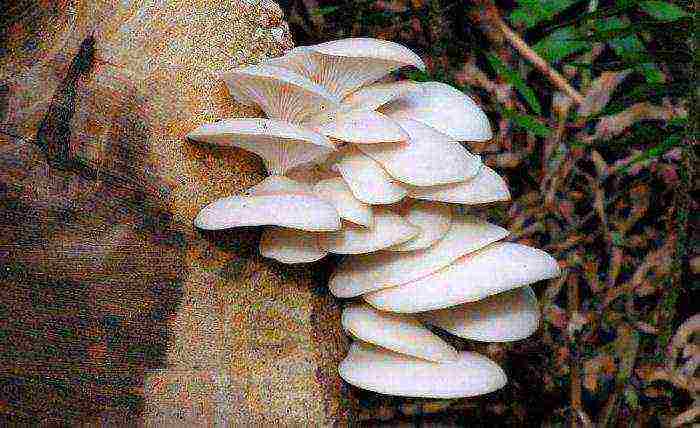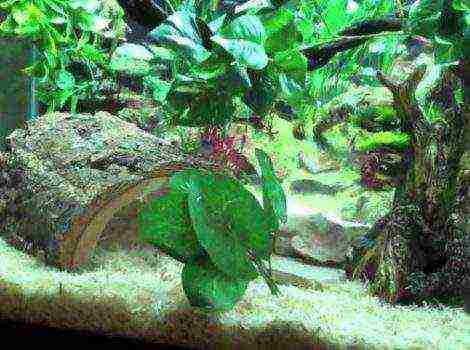Content
In recent years, more and more people have begun to master technologies that allow collecting oyster mushrooms on stumps. Growing these mushrooms at home does not require any special knowledge and skills. After reading this article, you will learn about the main stages of this process.
Mycelium selection
To collect oyster mushrooms on stumps, cultivation must begin with the acquisition of high-quality planting material. Some vendors offer to buy mycelium on sticks. However, long-term practice has shown that when using them, the first harvest can be obtained only after two years, and sometimes even later. Therefore, experts recommend purchasing fresh mycelium from oats or wheat. When choosing such planting material, you must make sure that there is no gray-green mold on it, the excess of which indicates the poor quality of the offered product.
When is it better to plant oyster mushrooms on stumps?
It is advisable to start growing these mushrooms in the autumn months. It is during this period that they do not require frequent watering, and the crop ripens much faster. If, with spring sowing, it will be possible to feast on mushrooms after a year and a half, then with autumn sowing - just a year later. In the first six months, oyster mushrooms require special care, which consists in frequent watering.
All of the above does not mean that you need to abandon the spring sowing of mycelium. It's just that in such cases, the logs with the future harvest are not buried in the ground, but placed in the basement and covered with wet burlap so that they gradually become overgrown with mycelium. In the fall, they are taken out of the cellar and buried in the ground.
Sowing technology
It should be understood that growing oyster mushrooms at home on stumps is a long and laborious process. In this case, you can only get a seasonal harvest, depending on climatic and weather conditions. The preparation of stumps must begin at the end of January. It is advisable to choose those on the surface of which there are no signs of mold. Before adding planting material, the logs should be soaked in water for three days. This will create the increased moisture required for the mycelium to be set. Stumps with mycelium can be taken out into the garden no earlier than May, when the threat of frost will completely disappear.
To get a good harvest of oyster mushrooms on stumps, cultivation and sowing can be done in several different ways:
- Holes are made in the logs, the depth of which is about six centimeters, and the diameter is about ten millimeters. Then they are filled with mycelium in grains and covered with moss or scotch tape.
- Planting material is laid out on the end of the stump and covered with a disc previously cut from a log, the thickness of which is about three centimeters, and then fixed with nails.
- A pyramid is built from the chocks, and the end of each log is covered with a two-centimeter layer of mycelium.
After sowing, the stumps are placed in a cellar and covered with burlap or foil.
Growing oyster mushrooms on stumps in the basement
In order for your venture to be crowned with success, it is necessary not only to choose the right mycelium, but also to create optimal conditions in the room chosen for these purposes. It is important that the air temperature in the basement is at least fifteen and no more than twenty degrees, and the humidity is within 80-95%.
It is recommended to pay special attention to providing good ventilation and lighting. It should also be understood that growing oyster mushrooms on stumps in the basement implies insulation and re-equipment of the room. To avoid carbon dioxide build-up, it is imperative to install fans. It is advisable to use fluorescent lamps as lighting devices.To place blocks with mushrooms in the basement, special racks should be equipped in advance. It is preferable that they are made of durable plastic that is resistant to moisture.
Transplant to open ground
In May, hemp with oyster mushrooms can be moved to the garden. The readiness for landing on open ground can be judged by the presence of a dense white bloom. For the most successful fruiting of myceliums, it is advisable to put the logs in the shade, for example, under densely leafy trees.
Wet leaves are lined at the bottom of the pre-dug pits, and then stumps are planted. It is important that the embedment depth of the logs does not exceed fifteen centimeters. The distance between adjacent chocks should be about half a meter. Further care of the plantings consists in periodically moistening the soil around the logs. The first crop can be harvested at the beginning of autumn.
With the onset of winter, it is recommended to wrap the hemp with spruce branches, leaves or straw. A similar mycelium will bear fruit abundantly for several years in a row. The maximum mushroom harvest can be harvested in the second and third years.
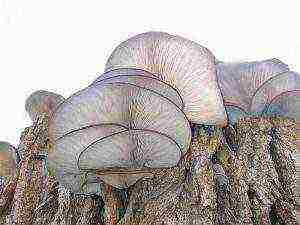
Growing oyster mushrooms is not a difficult process. It is quite possible to grow these mushrooms at home.
Mycelium (seeds)
The first step in growing oyster mushrooms will be the purchase of mycelium. It can be purchased from any mushroom growing company. Also, the mycelium is sold in online stores, sending it by mail. If this is your first time growing oyster mushrooms, buy up to one kilogram of mycelium. It will become the basis for obtaining about three to four kilograms of oyster mushrooms. Storage of mycelium should be carried out in the refrigerator for a period of 2-3 months. It is impossible to freeze the mycelium.
Opening the mycelium bags must be sterile, so treat it with a disinfectant solution and use gloves.

Tips for purchasing mycelium:
- Choose a trusted supplier with recommendations.
- Buy a trial batch before purchasing large quantities.
- Find out the type and strain of oyster mushrooms, the rate of mycelium growth, mold resistance, and do not forget to pay attention to the shelf life.
- Determine the temperature inside the mycelium (it is important not to overheat during delivery) - +20 degrees will be optimal.
- You shouldn't see black or green spots on the mycelium.
- The shade of the mycelium is normally bright orange. A little yellow exudate may be added to it.
 How to grow at home
How to grow at home
For self-cultivation of oyster mushrooms, two methods are used:
- Intensive
- Extensive
Intensive way
This is the name of growing mushrooms on a substrate placed in a plastic bag.
Its pluses:
- You can get a harvest of mushrooms regardless of the season.
- Mushrooms ripen quickly enough.
- You can make money by selling mushrooms.
Its cons:
- We need financial investments.
- You need a suitable room in which a certain microclimate is maintained.
 Room selection
Room selection
It is advisable to grow oyster mushrooms in a room that has:
- good thermal insulation;
- good ventilation system;
- height 3-5 meters;
- artificial lighting approximately 100 lux;
- source of clean water and sewage.
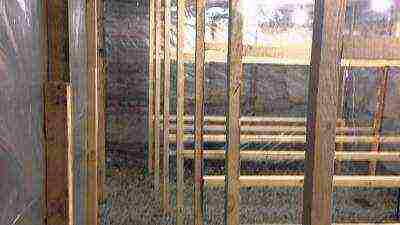
Suitable premises might be:
- Cellar;
- Basement;
- Poultry house;
- Fruit storage;
- Cowshed or pigsty;
- Granary;
- Vegetable store;
- Greenhouse;
- Garage;
- Pantry.
Remember that during fruiting on oyster mushrooms, many spores appear that can cause allergies, and therefore the room where the mushrooms are grown must be far from the living rooms.
 Substrate
Substrate
Next, you need to start preparing the substrate.
Oyster mushrooms are grown on:
- Sunflower husk;
- Barley straw;
- Buckwheat husk;
- Wheat straw;
- Chopped corn cobs;
- Shavings or sawdust of deciduous trees.
Beginners should choose straw, husk or husk as a substrate, since it is more difficult to grow mushrooms on sawdust and shavings. Make sure the raw materials are clean and free of mold.For a kilogram of mycelium, you need about ten kilograms of substrate. It should be crushed to obtain a fraction of 4-5 centimeters.
Thermal treatment of raw materials is also important, which will exclude its contamination and at the same time moisturize the substrate. The crushed raw material is placed in a large-volume container and completely filled with water, and then boiled for about two hours or less (the softer the raw material, the less it is boiled). The water is drained and the raw materials are cooled to + 25 + 28 degrees.
The result should be a moist substrate. To check if the raw material is waterlogged, you should squeeze it in your hands and see if water is flowing (a few drops may appear, this is permissible). Substrate treatment can be performed not only with hot water, but also with steam. Note that steam can be applied to both dry and already moistened substrates.
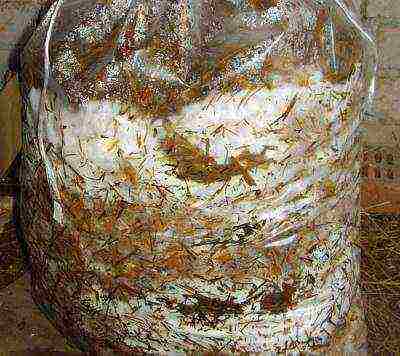 Mycelium bookmark
Mycelium bookmark
The substrate is placed in polyethylene, picking up the bags so that in the end there are about five kilograms of raw materials in one bag. Pre-disinfect the bags - first they need to be washed, and then soaked for an hour in a 1-2% solution of bleach. After this treatment, start filling the bags with the substrate. After every 5-6 centimeters of raw material, put the mycelium in a bag in a layer of about 0.5 centimeters. So fill the bags layer by layer to the top, so that the last layer is the substrate.
You can also simply mix the mycelium and the substrate so that the total mass of the mycelium is 3-5 percent for the mycelium from domestic producers and 1.6-2.5 percent for the mycelium from an imported manufacturer. Bags are filled with this mixture, and then tamped tightly.
Having tied the bag, perforation must be made over its entire surface in a checkerboard pattern. Let the distance between the holes or slots, the size of which will be 1-2 centimeters, is 10-15 centimeters.
 Incubation
Incubation
The next 10-25 days is the incubation period. By placing the blocks with the seeded substrate in the place where you will grow the mushrooms.
In this room, keep the temperature between 18 and 22 degrees Celsius. The room also needs to be ventilated several times daily, but make sure that flies do not get into it.
The temperature inside the bags will rise in the first three to four days, and it is important to prevent the substrate from heating more than +30 degrees so that the mycelium does not die. To lower the temperature, you can use a fan by directing it towards the blocks with mycelium. There is no need to illuminate the blocks at this stage. After three days, the filaments of the mycelium will become noticeable in the thickness of the substrate, and after about ten days they will completely fill the mushroom blocks. As a result, the blocks will become filled with a dense homogeneous mass, which will have a white color and a mushroom smell.
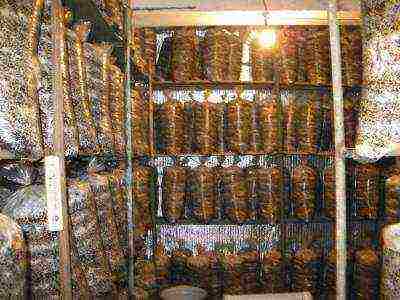 Harvesting
Harvesting
The last stage of growing oyster mushrooms is fruiting. To wait for it, immediately after the incubation period, you need to:
- Set the humidity to between 90 and 95 percent.
- Set the air temperature at + 10 + 15 degrees.
- Air the room up to four times daily.
To maintain a high level of humidity, you can start spraying the floor and walls with water, but make sure that water does not fall directly on the mushroom blocks.
If you create optimal conditions, you will soon see how the rudiments of oyster mushrooms appear in the slots. Mushrooms bear fruit for ten to fifteen days, rapidly increasing in size. When harvesting, do not cut the oyster mushrooms, but twist them out of the substrate. The color of the mushroom cap is influenced by lighting. Know that the more light falls on the mushrooms, the darker the caps of the oyster mushrooms will be.
Having collected the first crop, you should ventilate the room and wait for the second wave of the appearance of fruit bodies in about two weeks. In doing so, try to maintain the same conditions that you created for the first harvest of mushrooms. Also, after the first crop has been harvested, it is recommended to check the blocks and if they are found with mold, then take them out of the room, leaving only not infected.
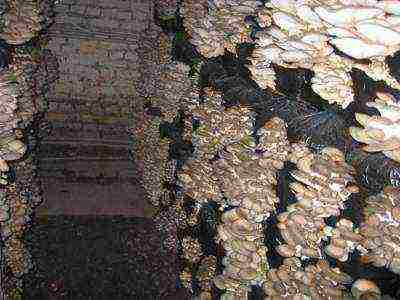
In total, mushrooms can bear fruit up to four times, but the highest yield is observed in the first two waves (they give about 75 percent).After harvesting the fourth wave, the blocks are replaced with others. Used blocks can be applied as fertilizer in the garden.
We invite you to visually familiarize yourself with the process of growing oyster mushrooms in the next video.
Ready-made mushroom blocks
A simpler option for growing oyster mushrooms at home is to buy ready-made blocks from companies specializing in the industrial cultivation of these mushrooms. Such blocks are supplemented with detailed instructions on how to successfully grow oyster mushrooms at home. The buyer only needs to place the blocks in the right room and provide the right conditions for the harvest to ripen.
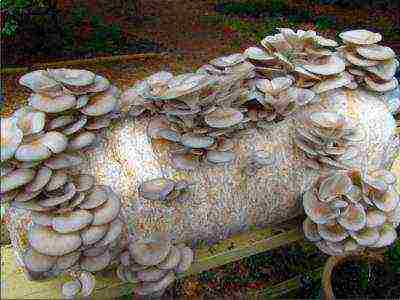 Extensive way
Extensive way
If it is not possible to obtain a suitable substrate, find a suitable room or create the conditions necessary for the fruiting of mushrooms in it, oyster mushrooms can be grown in an extensive way. It provides for growing mushrooms in the open air on stumps or logs. This method is also good for a beginner, as it requires a minimum of cash and labor costs. Its disadvantage is that such cultivation is influenced by the climatic conditions of the area, that is, seasonality is characteristic of such cultivation of oyster mushrooms.
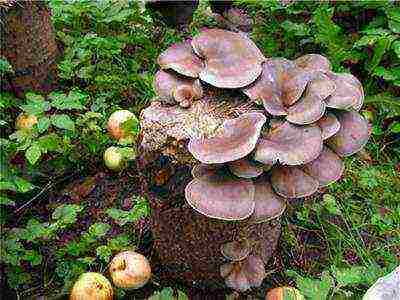 Preparing logs
Preparing logs
The preparation of logs and hemp begins at the end of winter. If there are stumps on the site left after the felling of trees, oyster mushrooms can also be grown on them, however, such stumps are sown during the period with the established above-zero temperature (April-May). If there are no such stumps, they take cuttings 30-50 cm long and 15-30 cm in diameter from ash, aspen, beech and other deciduous trees. Only healthy wood that is not infected with mold is suitable for growing mushrooms. Usually, the logs are soaked in water for several days - this will make the wood damp enough for the mycelium to develop in it. However, if the wood is not dry, then there is no need to soak it.
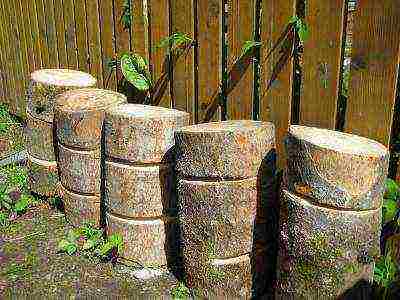 How to sow mycelium
How to sow mycelium
Sowing mycelium on logs is possible in several ways:
- Place the mycelium in the holes in the stumps. Logs are drilled or filed, creating holes five to six centimeters deep and about a centimeter in diameter. It is recommended to place these holes on stumps in a checkerboard pattern. If the mycelium is grain, it should be poured into the holes, then covered with moss or sealed with adhesive tape. If the mycelium is represented by sticks, they are inserted into the holes and then sealed with plasticine.
- Place the mycelium on the end of the log. From the hemp, you need to saw off a disk two to three centimeters thick. Cover the end of the remaining stump with mycelium, place the sawn-off disk on top and attach with nails.
- Make columns from logs. On the end of the log, 100-150 grams of mycelium are laid (the layer will be about 1-2 centimeters), then the second log is laid, on which the mycelium is again poured. Then the third log is laid and sprinkled with mycelium again. Thus, you can make columns with a height of 1.5-2 meters. For their greater stability, the logs used must have a sufficiently large diameter (more than 20 cm).
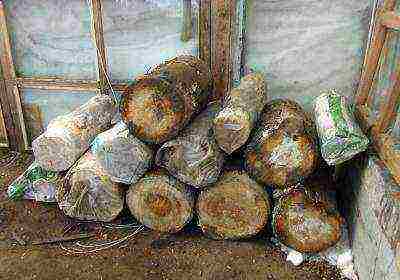
Having sown mycelium on logs, they are folded in a place where the temperature is maintained at about +15 degrees, leaving for two or three months. This can be a basement or a shed that can be regularly ventilated. If the first two methods were used for sowing, then the logs are folded horizontally one on top of the other, and then covered with burlap or perforated film. In the third method of sowing, the logs are placed vertically in several rows, filling the gaps between them with moistened straw or sawdust. From the sides, such columns are also covered with burlap or foil in order to maintain a fairly high humidity inside.
Planting logs
After a white bloom appears on the stumps, they should be planted in the ground in a shaded place. Most often this happens towards the end of spring. Pits are dug in the ground, on the bottom of which wet sawdust or wet leaves are laid. The stumps are placed in rows so that there is a distance of 35 to 50 centimeters between the logs.The cuttings are immersed in the ground for about 10-15 centimeters. Further, in case of dry weather, you should carefully water the soil around the stumps.
 Harvesting
Harvesting
The first oyster mushrooms begin to appear in August. If the fall is protracted, then the harvest can be harvested until November. For the winter period, hemp is covered with leaves or straw. You can also cover them with spruce branches.
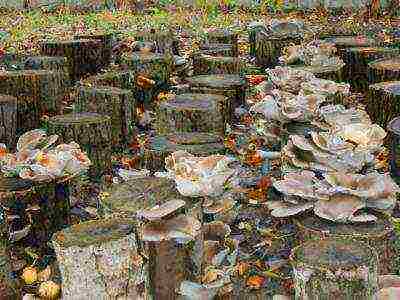
It is possible to get a mushroom harvest from such a stump plantation for up to five years. At the same time, the maximum fruiting of oyster mushrooms on stumps is noted in the second and third years.
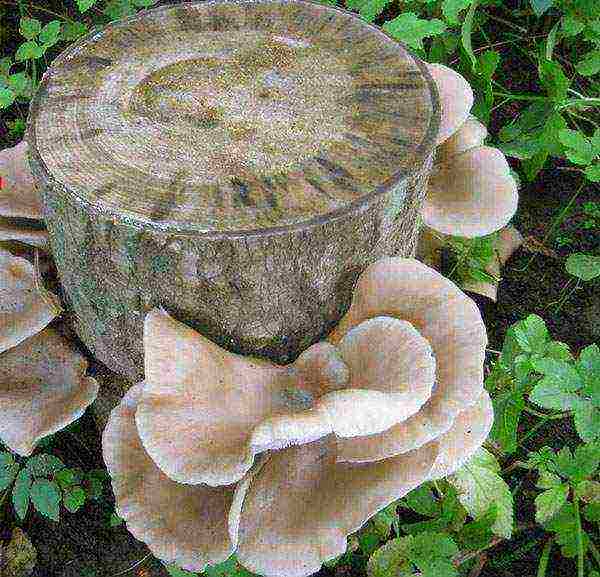 In nature, fungi parasitize on tree trunks. Their mycelium filaments can spread over long distances. The area of an adult mycelium ranges from 10 m2 to 15 m2, depending on the type of fungus. Oyster mushrooms are mushrooms that are unpretentious to growing conditions. Their spores infect deciduous trees. The mycelium can spread to the straw of cereals, such as wheat, as well as to sawdust of birch or oak.
In nature, fungi parasitize on tree trunks. Their mycelium filaments can spread over long distances. The area of an adult mycelium ranges from 10 m2 to 15 m2, depending on the type of fungus. Oyster mushrooms are mushrooms that are unpretentious to growing conditions. Their spores infect deciduous trees. The mycelium can spread to the straw of cereals, such as wheat, as well as to sawdust of birch or oak.
At their summer cottage, mushrooms are grown on stumps. They use firewood that was harvested a month ago. The logs are still wet and the bark can be easily removed from them, but most of the stump is already dry. Such wood is ideal for the development of mushroom mycelium.
Fungal spores can infect healthy trees in the garden. If the mycelium spreads to fruit trees, their yield will be significantly reduced, and three to four years after infection, the tree will die. Therefore, stumps with mushroom spores are placed away from the garden in a shaded place, for example, under the wall of a house.
Stump preparation
To grow mushrooms, you need to prepare the wood. Stumps with a diameter of 25 cm and a length of 50 cm are infected with spores. The stumps are sawn into three parts. Several holes are made in the first cut.
Use a nib drill. It is very difficult to drill holes with a conventional cartridge nozzle, since the wood is still wet. The depth of the holes must be at least 5 cm.
On the other side of the saw cut with a circular or gasoline saw, make several longitudinal and transverse cuts of the same depth. You will get a kind of mesh. Nails are hammered along the diameter of the logs, the caps of which are removed with nippers. Then they do a few simple steps:
- the first part of the log is filled with mycelium;
- then it is placed in the prepared hole with the holes down;
- a layer of mycelium is applied to the first part of the log;
- cover with the second part of the stump;
- another layer of mycelium is applied;
- cover with the last part of the stump.
The joints of the logs are wrapped with tape to protect the mycelium from ants. In order for the spores to germinate and give a fruiting body, the stumps infected with mycelium are placed in a shaded place on the site. After two months, you can harvest oyster mushrooms, provided that the logs are constantly moistened. They are watered every week.
Set up drip irrigation for stumps. Then the stumps do not have to be monitored until the harvest. Use a feather drill to make a groove in the third part of the log for the diameter of the neck of the plastic bottle. Cut off the bottom of the bottle, place it in the recess and fill with water.
The content of the article:
- Growing mushrooms on stumps at home
- What mushrooms can be grown on tree stumps?
- Preparing for planting mycelium
- Mycelium cultivation technology
- Where to place the plantation?
- The successes of the mushroom industry in Russia
Any reproduction of various mushroom cultures involves several basic cultivation methods. One of the easiest and most effective methods is the cultivation of mycelium using forest waste. The most practical is the use of stumps of different types of trees on which it grows in nature. This cultivation method is called extensive. It implies the course of the growing process in natural conditions, under the open sky. In rare cases, this can be done in a basement.With this option, monetary investments and material and technical base are minimal, and the yield is quite high. However, this will depend on the climatic conditions in which you are.
Growing mushrooms on stumps at home
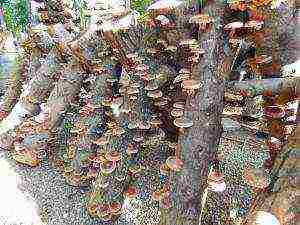 The extensive reproduction technique is well suited for home use. Taking into account the peculiarities of this technology, it is possible to achieve large production scales, but it is quite often used to satisfy only household needs. The landing of several dozen families will regularly supply you and your relatives with a quality product. Industrial production volumes can be achieved through high optimization and the use of the most productive genera.
The extensive reproduction technique is well suited for home use. Taking into account the peculiarities of this technology, it is possible to achieve large production scales, but it is quite often used to satisfy only household needs. The landing of several dozen families will regularly supply you and your relatives with a quality product. Industrial production volumes can be achieved through high optimization and the use of the most productive genera.
What mushrooms can be grown on tree stumps?
Under certain conditions, almost all types of mycelium are capable of growing on wood. Mushroom yields will vary considerably. In practical plant growing today, it is customary to cultivate two types of edible mushrooms: oyster mushrooms and honey agarics. However, it is most advisable to grow oyster mushrooms. This genus of wild plants gives the highest yield and cyclicality throughout the year. The technology of reproduction of different genera of this kingdom of botany on wood blocks is identical. Only the natural ability of various mycelium variants to bear fruit in a woody environment differs.
Preparing for planting mycelium
To carry out the procedure for infecting a timber stock with a seed mixture, a minimum amount of materials is required:
- Wooden log.
- Mycelium.
- Ancillary equipment.
For the purpose of cultivation, you can pick up any options for low-grade wood. But it is better to prepare those varieties on which the spores prefer to grow in natural conditions. The logs should not be older than 1-2 years. It is advisable to choose options with minimal signs of destruction, since mushrooms wear out the tree very aggressively and your growing environment will quickly exhaust its resource.
It is best to cook a wet and fairly fresh breed. The diameter of the blanks can vary from 15 to 30 cm. The optimal option is 20-25 cm. As mentioned, the most economically profitable family for home and industrial production is oyster mushroom. Mycelium of this kind is realized in several forms: various containers, plastic bags.
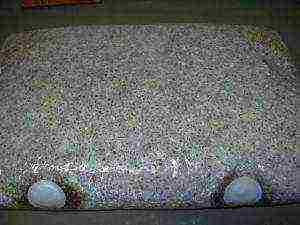 The main nuances worth knowing about are the substrate on which the mycelium is grown. The main types are: cereal grains, sawdust, bars, corn cobs. There is an opinion that the most promising option is a sowing medium grown on grains. However, no significant differences were found in base modifications. Storage of the cultivation substrate should not exceed 6-7 months. Otherwise, the prospect of reproduction of the dispute is reduced. It is best to plant fresh, healthy material.
The main nuances worth knowing about are the substrate on which the mycelium is grown. The main types are: cereal grains, sawdust, bars, corn cobs. There is an opinion that the most promising option is a sowing medium grown on grains. However, no significant differences were found in base modifications. Storage of the cultivation substrate should not exceed 6-7 months. Otherwise, the prospect of reproduction of the dispute is reduced. It is best to plant fresh, healthy material.
The main requirements for storing mycelium are temperature (+ 2 ° C) and humidity. A quality planting substrate is a white conglomerate that is hard to the touch. If it is significantly changed, then there will be no harvest. The extensive method involves the use of micelated gruel or water, which is easy to pour into the seating nests. The tools with which you will prepare logs for infection can be varied. Your best bet is to have:
- drill;
- chainsaw;
- industrial film;
- locksmith staple;
- container for sterilizing logs.
Mycelium cultivation technology
For sowing oyster mushrooms or other genera, wooden logs are harvested, which are sawn into blocks of 30-40 cm, pre-soaking them in ordinary water for 1-2 weeks. If the blanks are freshly cut logs, then they do not need to be soaked. The entire infection algorithm boils down to the following basic manipulations:
- Digestion of wooden blocks.
- Cutting out niches of primary growth.
- Seed medium preparation.
- Infection.
- Log wrapping.
To prevent the competitive growth of various microorganisms with fungi in the environment of wood and the destruction of antifungal substances, the method of heat treatment of the bar is used. To do this, place the logs in boiling water for 15-30 minutes.
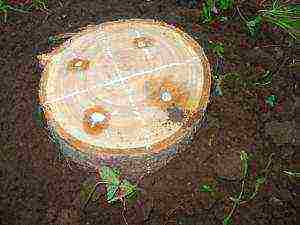 For a better invasion of spores into a wooden blank and protecting it from adverse external influences, it should be correctly placed in a log. For this, several methods are used. The first, and the simplest, consists in placing the mycelium on the end of the bar and laying on top of the next one. Thus, an artificial trunk is formed, in which each next layer protects the mycelium of the previous one. Straw or sawdust is laid on the surface of the uppermost one.
For a better invasion of spores into a wooden blank and protecting it from adverse external influences, it should be correctly placed in a log. For this, several methods are used. The first, and the simplest, consists in placing the mycelium on the end of the bar and laying on top of the next one. Thus, an artificial trunk is formed, in which each next layer protects the mycelium of the previous one. Straw or sawdust is laid on the surface of the uppermost one.
The second method is the imposition of holes on the log, which serves as a protection. To do this, use a conventional drill to drill several holes up to 1-15 cm in diameter to a depth of 10 cm. The method of sawing the upper layer of the bar is also used. For its implementation, a 4-centimeter layer of log is cut down. The mycelium is placed on it and covered like a lid. Then fix it with nails.
To achieve the desired consistency, the mycelium is ground by hand and placed tightly in niches for cultivation. Then they are tightly sealed with wooden valves or paper wads for better incubation.
The micellar environment constantly requires a certain water content for growth. The logs must be kept at 80% moisture for growth to be successful. To preserve this environment, the hemp is wrapped in plastic wrap and fixed with staples. For good incubation, the workpieces are placed in a basement or in a building with minimal direct sunlight.
Where to place the plantation?
 The bars are overgrown in 2 - 2.5 months. After about this time, the first traces of young growth appear on them. This is a good sign. Now the logs can be installed in their place of permanent residence. This is best done in a shaded garden. There they are buried to a depth of 10 cm. Now that your mushroom garden is ready, you need to periodically water it in very dry weather and harvest.
The bars are overgrown in 2 - 2.5 months. After about this time, the first traces of young growth appear on them. This is a good sign. Now the logs can be installed in their place of permanent residence. This is best done in a shaded garden. There they are buried to a depth of 10 cm. Now that your mushroom garden is ready, you need to periodically water it in very dry weather and harvest.
The successes of the mushroom industry in Russia
Taking into account the traditional use of oyster mushrooms, whites and other species of this plant organism in the Russian diet, mushroom cultivation is one of the most promising directions in plant growing. Every year the share of Russian companies in the segment of this type of production is significantly increasing.
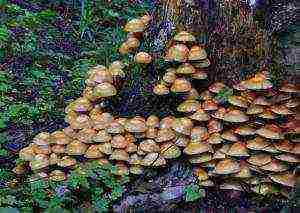 In 2015, the supply of this kind of food products increased by 22%. The departure of foreign importers from the Russian market provides an excellent opportunity for domestic manufacturers, the volume of supplies of which covers only 10-15% of the Russian market. Companies involved in this segment show successful and stable economic growth. Some of the most successful mushroom growing enterprises in Russia are the industrial groups of the Moscow region and the Upper Volga region. Companies that occupy a large part of the Russian market show a constant increase in production and high profits: the Zapadny refrigeration plant (TM 4 seasons), Ledovo (TM Snezhana), Ledyanoy Mir (TM Smak), Khladokombinat No. 1 "(St. Petersburg)," Elikom ".
In 2015, the supply of this kind of food products increased by 22%. The departure of foreign importers from the Russian market provides an excellent opportunity for domestic manufacturers, the volume of supplies of which covers only 10-15% of the Russian market. Companies involved in this segment show successful and stable economic growth. Some of the most successful mushroom growing enterprises in Russia are the industrial groups of the Moscow region and the Upper Volga region. Companies that occupy a large part of the Russian market show a constant increase in production and high profits: the Zapadny refrigeration plant (TM 4 seasons), Ledovo (TM Snezhana), Ledyanoy Mir (TM Smak), Khladokombinat No. 1 "(St. Petersburg)," Elikom ".
The success of these and many other farms lies in the high demand for this product and the rather easy technological process of growing. The market in our country has a large deficit in this sector and is one of the most promising in the economy. The peculiarities of obtaining the product make it possible to achieve high profitability and payback of the goods. Most regions in the country are suitable for this type of business. Government programs and subsidies stimulate the development of large manufacturing companies and small private farms.
